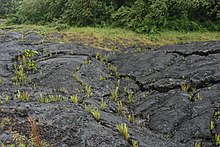
Back أنواع رائدة Arabic Pionýrský druh Czech Pionerart Danish Pionierpflanze German Pionirplanto Esperanto Especie pionera Spanish Pioneerliik Estonian گونه پیشگام Persian Pioneerilaji Finnish Espèce pionnière French


Pioneer species are resilient species that are the first to colonize barren environments, or to repopulate disrupted biodiverse steady-state ecosystems as part of ecological succession. A number of kinds of events can create good conditions for pioneers, including disruption by natural disasters, such as wildfire, flood, mudslide, lava flow or a climate-related extinction event[1] or by anthropogenic habitat destruction, such as through land clearance for agriculture or construction or industrial damage. Pioneer species play an important role in creating soil in primary succession, and stabilizing soil and nutrients in secondary succession.[2]
For humans, because pioneer species quickly occupy disrupted spaces they are sometimes treated as weeds or nuisance wildlife, such as the common dandelion or stinging nettle.[3][2] Even though human have mixed relationships with these plants, these species tend to help improve the ecosystem because they can break up compacted soils and accumulate nutrients that help with a transition back to a more mature ecosystem.[4][5][2] In human managed ecological restoration or agroforestry, trees and herbaceous pioneers can be used to restore soil qualities and provide shelter for slower growing or more demanding plants.[5][6][7] Some systems use introduced species to restore the ecosystem,[2] or for environmental remediation.[8] The durable and characteristics of pioneer species can also make them to become potential invasive species, or interfere with biodiversity by quickly occupying an area.[9] [2][10]
- ^ Duram, Leslie A. (2010). Encyclopedia of Organic, Sustainable, and Local Food. ABC-CLIO. p. 48. ISBN 9780313359637.
- ^ a b c d e Dalling, J. W. (2008-01-01), "Pioneer Species", in Fath, Brian (ed.), Encyclopedia of Ecology (Second Edition), Oxford: Elsevier, pp. 181–184, ISBN 978-0-444-64130-4, retrieved 2024-04-13
- ^ "Taraxacum officinale". www.fs.usda.gov. Retrieved 2024-04-13.
- ^ Cacace, Claudio; García-Gil, Juan C.; Cocozza, Claudio; De Mastro, Francesco; Brunetti, Gennaro; Traversa, Andreina (2022-11-03). "Effects of different pioneer and exotic species on the changes of degraded soils". Scientific Reports. 12 (1): 18548. Bibcode:2022NatSR..1218548C. doi:10.1038/s41598-022-23265-y. ISSN 2045-2322. PMC 9633587. PMID 36329111.
- ^ a b Steinfeld, Jonas P.; Miatton, Massimiliano; Creamer, Rachel E.; Ehbrecht, Martin; Valencia, Vivian; Ballester, Maria Victoria Ramos; Bianchi, Felix J. J. A. (2024-03-01). "Identifying agroforestry characteristics for enhanced nutrient cycling potential in Brazil". Agriculture, Ecosystems & Environment. 362: 108828. Bibcode:2024AgEE..36208828S. doi:10.1016/j.agee.2023.108828. ISSN 0167-8809.
- ^ Swinfield, Tom; Afriandi, Roki; Antoni, Ferry; Harrison, Rhett D. (2016-12-01). "Accelerating tropical forest restoration through the selective removal of pioneer species". Forest Ecology and Management. 381: 209–216. doi:10.1016/j.foreco.2016.09.020. ISSN 0378-1127.
- ^ Cortines, Erika; Valcarcel, Ricardo (October 2009). "Influence of pioneer-species combinations on restoration of disturbed ecosystems in the Atlantic Forest, Rio de Janeiro, Brazil". Revista Árvore. 33 (5): 927–936. doi:10.1590/S0100-67622009000500015. ISSN 0100-6762.
- ^ Wu, Jiamei; Zhang, Chenxu; Yang, Huifen; Chen, Pan; Cao, Jian (January 2023). "Combined Remediation Effects of Pioneer Plants and Solid Waste towards Cd- and As-Contaminated Farmland Soil". Applied Sciences. 13 (9): 5695. doi:10.3390/app13095695. ISSN 2076-3417.
- ^ Swinfield, Tom; Afriandi, Roki; Antoni, Ferry; Harrison, Rhett D. (2016-12-01). "Accelerating tropical forest restoration through the selective removal of pioneer species". Forest Ecology and Management. 381: 209–216. doi:10.1016/j.foreco.2016.09.020. ISSN 0378-1127.
- ^ Seidler, Reinmar (2024-01-01), "Biodiversity in Anthropogenically Altered Forests", in Scheiner, Samuel M. (ed.), Encyclopedia of Biodiversity (Third Edition), Oxford: Academic Press, pp. 80–97, ISBN 978-0-323-98434-8, retrieved 2024-04-13
© MMXXIII Rich X Search. We shall prevail. All rights reserved. Rich X Search